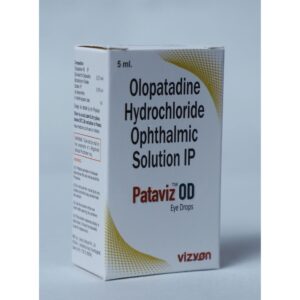HYDROCHLORIDE + OLOPATADINE
Hydrochloride: Hydrochloride is not a specific drug but rather a salt form of various medications. It is commonly used as a salt form for a wide range of drugs, including but not limited to antibiotics, antihistamines, antidepressants, and antipsychotics.
The use of hydrochloride depends on the specific drug it is combined with. For example, hydrochloride salts of antibiotics like amoxicillin or clarithromycin are used to treat bacterial infections, while hydrochloride salts of antihistamines like cetirizine or loratadine are used to alleviate allergy symptoms.
The mechanism of action varies depending on the drug. Hydrochloride salts themselves do not have pharmacological activity. Instead, they are combined with a drug to enhance its properties such as solubility and stability.
The dosage of hydrochloride will depend on the specific drug being used. Different medications have different recommended doses, and it is essential to follow the dosage instructions provided by the healthcare professional or specified in the drug’s package insert.
As for side effects, these also vary depending on the particular drug being used in hydrochloride form. Common side effects can include drowsiness, dizziness, nausea, vomiting, headache, and constipation. However, the specific side effects, severity, and potential adverse reactions can vary greatly between different medications.
It is crucial to consult with a healthcare professional or pharmacist for specific information regarding the use, mechanism of action, dosage, and potential side effects of a drug that contains hydrochloride as its salt form since the characteristics will depend on the specific medication.
Olopatadine: Olopatadine is a medication used primarily to treat allergic conjunctivitis, also known as eye allergies. It belongs to a class of drugs called antihistamines, specifically H1 receptor antagonists.
Mechanism of action:
Olopatadine works by blocking the effects of histamine, a natural substance released by the body during an allergic reaction. Histamine is responsible for causing symptoms such as itching, redness, and swelling of the eyes. By blocking the H1 receptors, olopatadine helps reduce these symptoms.
Use:
Olopatadine is available as eye drops and is used to relieve seasonal and perennial allergic conjunctivitis symptoms, including itching, redness, tearing, and swelling of the eyes. It is not recommended for use in children below 3 years of age.
Dose:
The usual recommended dose for adults and children over 3 years of age is one drop in each affected eye twice a day, with at least 6 to 8 hours between doses. It is important to follow the instructions provided by the healthcare professional or as mentioned on the packaging.
Side effects:
Common side effects of olopatadine eye drops include burning or stinging sensations in the eyes, dryness, itchiness, and blurred vision. These are usually mild and temporary. However, if these side effects persist or worsen, it is advisable to consult a healthcare professional.
In rare cases, serious allergic reactions may occur. If you notice symptoms such as severe itching/swelling of the eyes or face, rash, dizziness, or difficulty breathing, seek immediate medical attention.
It is worth noting that olopatadine eye drops are for external use only and should not be ingested. If accidentally swallowed, seek medical help immediately.
As with any medication, it is important to inform your healthcare provider of any pre-existing medical conditions, ongoing medications, or allergies, as they can interact with olopatadine. It is also essential to discuss the suitability of olopatadine if you are pregnant or breastfeeding.
This description provides an overview of olopatadine, but it is always recommended to consult a healthcare professional or read the product information for specific instructions and guidance tailored to your individual needs.

